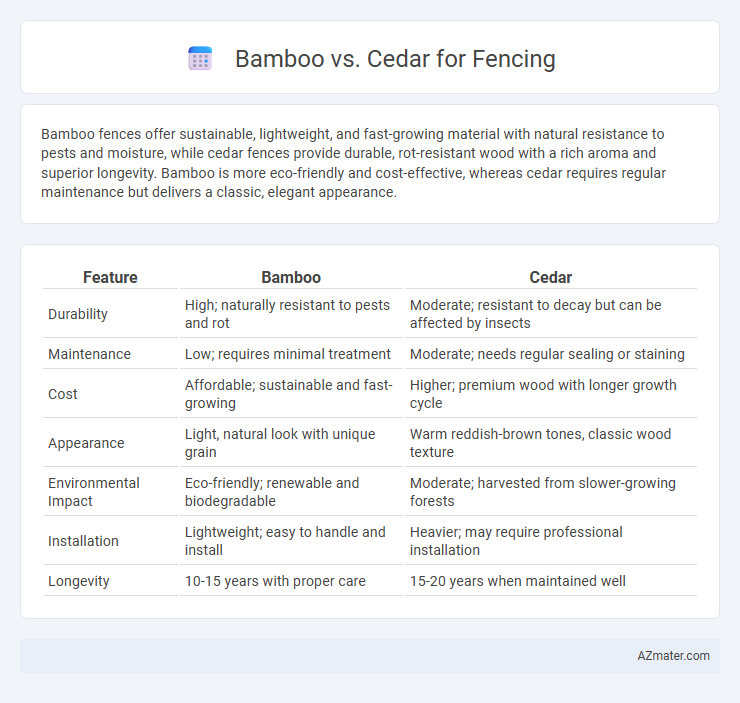Bamboo fences offer sustainable, lightweight, and fast-growing material with natural resistance to pests and moisture, while cedar fences provide durable, rot-resistant wood with a rich aroma and superior longevity. Bamboo is more eco-friendly and cost-effective, whereas cedar requires regular maintenance but delivers a classic, elegant appearance.
Table of Comparison
| Feature | Bamboo | Cedar |
|---|---|---|
| Durability | High; naturally resistant to pests and rot | Moderate; resistant to decay but can be affected by insects |
| Maintenance | Low; requires minimal treatment | Moderate; needs regular sealing or staining |
| Cost | Affordable; sustainable and fast-growing | Higher; premium wood with longer growth cycle |
| Appearance | Light, natural look with unique grain | Warm reddish-brown tones, classic wood texture |
| Environmental Impact | Eco-friendly; renewable and biodegradable | Moderate; harvested from slower-growing forests |
| Installation | Lightweight; easy to handle and install | Heavier; may require professional installation |
| Longevity | 10-15 years with proper care | 15-20 years when maintained well |
Introduction to Bamboo and Cedar Fencing
Bamboo fencing offers a sustainable, fast-growing alternative with natural resistance to insects and moisture, making it ideal for eco-friendly outdoor boundaries. Cedar fencing, prized for its durability and rich reddish-brown color, naturally repels decay and pests while providing a classic aesthetic that ages gracefully over time. Both materials are valued for their strength and visual appeal, but bamboo tends to emphasize sustainability and rapid growth, whereas cedar is known for longevity and traditional elegance.
Material Durability: Bamboo vs Cedar
Bamboo fence material offers exceptional durability due to its natural resistance to moisture, insects, and rot, often lasting 15-20 years with proper maintenance. Cedar provides strong durability as well, known for its natural oils that repel insects and resist decay, typically enduring 20-25 years in outdoor conditions. Both materials require periodic sealing to enhance longevity, but cedar generally outperforms bamboo in long-term durability against harsh weather.
Aesthetic Appeal: Design and Style
Bamboo fences offer a sleek, modern aesthetic with clean lines and natural textures, creating a tropical or Zen-inspired ambiance. Cedar provides a classic, warm appearance with rich reddish hues and natural grain patterns that enhance traditional or rustic design styles. Both materials adapt well to various architectural themes, but bamboo emphasizes contemporary minimalism while cedar aligns with timeless elegance.
Sustainability and Environmental Impact
Bamboo fences offer remarkable sustainability due to bamboo's rapid growth rate--up to 3 feet per day--and its ability to regenerate without requiring replanting, making it a highly renewable resource compared to cedar. Cedar, while naturally resistant to decay and insects, grows significantly slower and often undergoes chemical treatments that can impact soil and water quality. Bamboo's carbon sequestration capacity and minimal chemical use contribute to a lower environmental footprint, positioning it as a greener choice for eco-conscious fencing.
Maintenance Requirements
Bamboo fences require minimal maintenance, needing only occasional cleaning and periodic sealing to prevent moisture damage and insect infestation. Cedar fences demand more upkeep, including regular staining or sealing to protect against weathering, as well as annual inspections for rot or pest damage. Both materials benefit from consistent care, but bamboo's natural resistance to decay reduces long-term maintenance efforts compared to cedar.
Cost Comparison: Bamboo vs Cedar Fences
Bamboo fences typically cost between $15 to $30 per linear foot, offering an affordable and eco-friendly alternative compared to cedar fences, which range from $25 to $45 per linear foot. Bamboo's rapid growth allows for sustainable harvesting, often resulting in lower installation and maintenance expenses. Cedar fences, prized for their durability and natural resistance to decay, tend to incur higher upfront costs and require periodic treatments to maintain longevity.
Weather Resistance and Longevity
Bamboo fences offer excellent weather resistance, with natural oils that repel moisture and resist insect damage, making them durable in humid and wet climates. Cedar fences are also highly weather-resistant, containing natural compounds that prevent rot and decay, resulting in a lifespan of up to 20 years with proper maintenance. Both materials provide longevity, but cedar typically requires more upkeep, while bamboo's rapid growth and sustainability add ecological benefits to its durable performance.
Installation Process and Complexity
Bamboo fences typically offer quicker installation due to their lightweight and flexible nature, requiring minimal cutting and simpler fastening methods such as zip ties or wire. Cedar fences demand more precise measurements, cutting, and nailing, often involving pre-treatment and staining to enhance durability and aesthetics. The complexity of cedar installation is higher, involving heavy panels or planks and post setting, which requires more time and specialized tools compared to the straightforward assembly of bamboo.
Privacy and Security Factors
Bamboo fences provide excellent privacy due to their dense, tall growth pattern, effectively blocking sightlines and reducing noise intrusion. Cedar fences offer strong security with sturdy, thick wooden panels that are resistant to warping and can be built at varying heights for enhanced protection. Both materials are durable and weather-resistant, but bamboo's rapid growth and natural density often make it a superior choice for quick privacy, while cedar's solid structure adds a robust barrier against potential intrusions.
Final Verdict: Which Fence Material is Best for You?
Bamboo fences offer eco-friendly, lightweight, and cost-effective solutions ideal for sustainable landscaping and tropical aesthetics, while cedar fences provide superior durability, natural resistance to decay, and classic appearance suitable for long-lasting privacy barriers. Homeowners seeking low maintenance and fast installation may prefer bamboo, whereas those prioritizing longevity and structural strength often choose cedar. Final selection depends on climate tolerance, budget constraints, and desired fence lifespan for optimal performance.

Infographic: Bamboo vs Cedar for Fence
 azmater.com
azmater.com